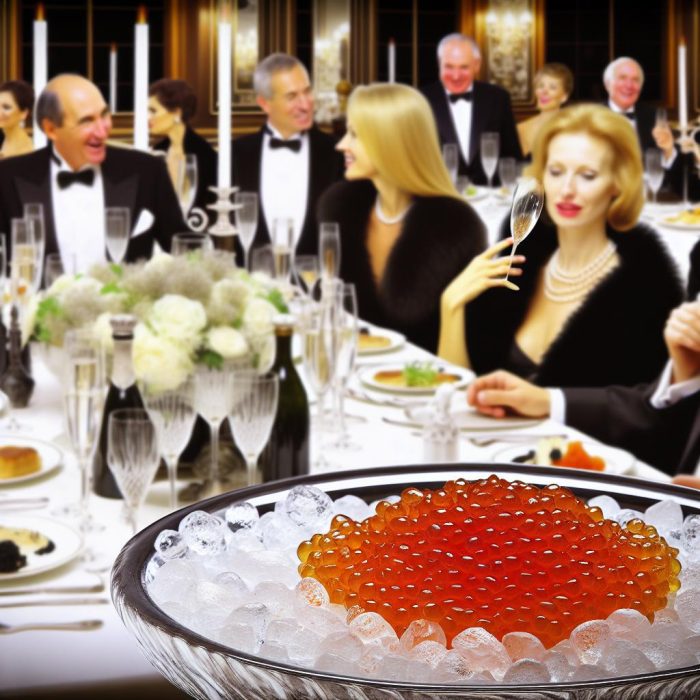The Origins of Caviar
Caviar, a luxurious food product traditionally derived from the roe of sturgeon fish, has a rich history that spans several centuries. This exquisite delicacy finds its roots along the Caspian and Black Sea shores, regions renowned for producing the world’s finest caviar. Historical evidence suggests that the extraction and subsequent consumption of fish roe date back to ancient Persia. However, the term “caviar” did not come into popular use until much later, carrying with it a legacy of opulence and indulgence that resonates to this day.
The consumption of roe, or fish eggs, was not only a part of early human diets but also carried various cultural significances. In ancient Persia, roe was consumed more out of nutritional necessity than luxury, yet it laid the foundations for what caviar would become. The transition of caviar to a luxury item began as it spread across Europe, gaining particular prominence during the Middle Ages. It was within the courts of kings and the homes of the wealthy that caviar began to earn its reputation as an exquisite and sought-after delicacy.
Sturgeon: The Source of Luxury
The sturgeon fish, particularly the species of Beluga, Osetra, and Sevruga, have historically been the most coveted for their rich, flavorful roe. These species are native to the brisk and nutrient-rich waters of the Caspian Sea, conditions that significantly contribute to the quality and uniqueness of the caviar produced. The rarity and exclusivity associated with caviar are primarily due to the lengthy maturation period of sturgeon, with some species taking several decades to reach full maturity, and the intricate, labor-intensive process required to carefully harvest and process the delicate roe.
The decline in sturgeon populations over the years has further elevated caviar’s status as one of the most expensive food items in the world. Overfishing and environmental factors have significantly reduced wild sturgeon numbers, prompting stringent regulations and conservation efforts to protect these ancient fish. As a result, caviar production has increasingly shifted towards sustainable farming practices to meet demand while attempting to preserve these crucial aquatic species.
From Royal Courts to the Aristocracy
Caviar’s ascent as a symbol of affluence and luxury can be traced back to the 16th century when it began to be a staple within the courts of Russian tsars and European royalty. It was during this period that caviar became associated with affluence and sophistication. The presence of caviar at banquets and lavish gatherings hosted by the nobility served to further cement its image as a luxury product synonymous with wealth and prestige.
The exclusivity of caviar was not only due to its distinct taste and texture but also because of its rarity and the status it conferred upon those who could afford it. This association with the elite classes of Europe was strengthened as the popularity of caviar spread across the continent, becoming a favored delicacy among the aristocracy and further engraining its reputation as a luxurious indulgence.
Global Expansion and Popularity
The 19th and early 20th centuries marked a turning point for caviar, as the culinary delicacy began to gain a more global appeal. Entrepreneurs, most notably the Petrossian brothers in Paris, were instrumental in popularizing and commercializing caviar, making it a recognizable luxury item worldwide. Their efforts helped to elevate caviar’s status and broaden its appeal to affluent consumers beyond the European continent, significantly contributing to its modern-day image.
The expansion of caviar markets was facilitated by the establishment of international dining establishments, which featured it as a premium dish on their menus, and by the importation of sturgeon roe from various countries outside of its traditional geographic origins. This globalization of caviar not only increased its availability but also solidified its standing as a luxury commodity throughout much of the Western world.
Modern Day Significance
In contemporary times, caviar continues to hold its position as a symbol of opulence and prestige. It is often associated with high-end dining experiences, luxury events, and elite social gatherings. The meticulous regulation and legislative measures enacted to preserve sturgeon populations have ensured that caviar retains its allure as a premium product. These regulations, combined with the careful and sustainable farming practices adopted by modern producers, contribute to the continued demand and prestige associated with caviar in the global market.
The rising popularity of sustainable and ethical alternatives, such as farm-raised and other non-sturgeon caviars, indicates the ongoing interest in this culinary delicacy, reinforcing its status as a hallmark of elegance and refinement. These alternatives offer a viable solution to meet high demand while alleviating some of the pressures on wild sturgeon populations, ensuring the longevity of caviar as a cherished component of gourmet cuisine.
Challenges and Sustainability
Caviar faces significant challenges, primarily stemming from its high demand and the resulting impact on sturgeon populations. Overfishing has historically led to a dramatic decline in wild sturgeon numbers, necessitating changes in regulations and industry practices to emphasize sustainability. In response, many contemporary producers are focusing on ethical methods and environmentally responsible farming solutions to ensure that caviar production can continue without threatening the existence of natural sturgeon species.
Efforts to promote sustainable caviar practices include initiatives aimed at habitat conservation, improved aquaculture techniques, and stringent controls on harvesting and exporting. These developments aim to balance the desire for high-quality caviar with the need for ecologically sound production methods, ensuring that this luxurious delicacy can be enjoyed by future generations.
Conclusion
The story of caviar, from its ancient origins to its present-day status as a luxury food item, underscores its profound cultural and historical importance. While it continues to symbolize wealth and high society, the challenges it faces—particularly those concerning sustainability—require conscientious approaches to guarantee its future availability. As these solutions evolve, they offer hope for the continued enjoyment of caviar as a uniquely refined culinary experience. For more information on sustainable practices in caviar production, you can visit the Caviar Star website.

